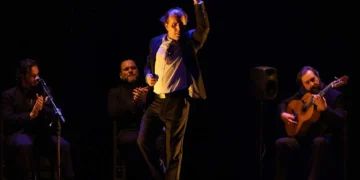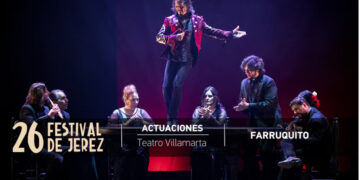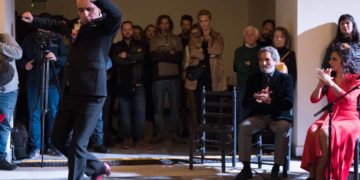|
«HOMENAJE» Pepe Torres with Guest Artist Juan Del Gastor |
| Text: Maya de Silva Chafe
Pepe Torres opened his new show “Homenaje” in a very direct and simple manner: alone onstage playing the sweetest, most tragic and soulful, heartfelt siguiriyas I have heard in a long time on the flamenco guitar. The guitar was invented in Spain, descending from the prototypes of the Turkish al’oud and the Reniassance mandolin, and after hearing this seven-minute journey through the landscape of the soul, I am more convinced than ever that the guitar and flamenco were invented for each other. They are so perfectly suited for exploration of the most delicate sentiments, the deepest passions, the wildest fantasies and the most basic human truths, those that we confront each time we see ourselves again. His eyes shone with such intensity as they gazed into ours, pouring every grain of himself out through the guitar and his fingers, opening his most secret doors and setting out all of his gifts for me to choose from. The distillation of all that is the best of flamenco, the most authentic and pure, without needing to label itself as such.  Pepe Torres This brilliant opening set the tone for the evening, which was nothing but simple and direct. It seems that the financial catastrophe that both Spain and America find themselves in the middle of, may have had one of the best unintended effects ever: we have gotten a show that is the distillation of all that is the best of flamenco, the most authentic and pure, without needing to label itself as such. Instead of a two to three week extravaganza of performances by everyone from the most cutting edge contemporary flamenco of Rocio Molina and Rafaela Carrasco, to our old favorites Los Farrucos and Sara Baras, (along with films, art exhibits, symposiums, lectures and cuisine festivals), this year the World Music Institute has scaled way back and brought us only two shows: “Homenaje”, with artistic director Pepe Torres and “Gitaneria” featuring Angelita Vargas and Jairo Barrull. But we are getting quality rather than quantity this time, folks! Now that they are touring to San Francisco and Boston, I urge you to get to these shows in the best seats possible. I loved all the bells and whistles we had in those flush times, but if we must do with less, then this is exactly the quality of work I most want to see. The gypsy dynasties are an interconnected entity, with family and friends living in close proximity, moving in the same circles and influencing each other over generations. This theme ran through the two concerts and so, even though they are not directly related, it was it was fitting that Angelita and Jairo would close this two-night concert series performing together, as they are a good match in purity of gypsy style. Pepe Torres: the package as a whole cannot be received with anything other than complete enthusiasm…so charming, so unassuming, so willing to share his true artistry, that we are willing to go anywhere with him. Pepe Torres staged his show to be a tribute to his grandfather, flamenco singer Luis Torres Cádiz “Joselero de Moron”. To quote the program: “Torres is a descendant of one of the most revered gypsy dynasties, epitomized by his granduncle the legendary guitarist Diego del Gastor…..[he] grew up listening to his grandfather Joselero sing at family gatherings with his uncles, guitarist Dieguito de Moron and singer/dancer Andorrano, and other members of the extended family including Agustin and Pepe Rios and Paco and Juan del Gastor.” Pepe Torres honored his family in bringing us a wonderful dose of the traditional style in this US premiere (subtitled “A Centennial Tribute to Joselero de Moron”). His uncle Juan del Gastor was featured along with the excellent guitarist brothers Enrique and Paco Iglesias, and he also brought three cantaores to provide the backbone of his show. Luis Moneo excelled in his soleá and his tientos, his strength lies in solo cante where the singer is not backing up a dancer, but up front beside the supporting guitarist, in this case a sensitive and stylish Enrique Iglesias. Enrique is well-known to New York flamenco aficionados, having graced our stages with his superb technique and gorgeous compositions whenever he has come with Soledad Barrios and Noche Flamenca. He shone particularly well with this group, and interfaced very nicely with his brother Paco. The bothers and all three cantaores David Sanchez “El Gayi”, Juan Jose Amador and Luis Moneo served as the musicians for both groups. The brothers played a very beautiful and complex guitar duet in the Sunday night show “Gitanería”. Called simply “Iglesias”, it slid between a 4/4 and a 12-count rhythm, seamlessly shifting between these complexities while taking us through sweet and cheery places. Of the singers, “El Gayi” was by far the strongest, a veritable powerhouse, with great depth and range (and some of the best palmas I’ve ever heard) who works often with Torres. It was apparent that he also served as unofficial musical director on Sunday night when the singers and guitarist were less familiar with the dancers’ routines and habits. Although Sánchez and Moneo were noteworthy, I’m not sure why they brought Amador. His nasal delivery and nervousness onstage did nothing for me. Juan del Gastor: a living legend, embodying the kind of beautiful humanity that we see in Torres, but from another generation…funny, sincere, defiant and elegant, with a unique style that is quintessential Morón. On the other hand Juan del Gastor is a living legend, embodying the kind of beautiful humanity that we see in Torres, but from another generation. He is funny, sincere, defiant and elegant all at once, with a unique style that is quintessential Morón. When he accompanied Moneo in the soleá his guitar never said more or less than was called for. He embodies a school of clean, simple direct playing that is the antithesis of artifice or unnecessary adornments. We all love Tio Juan and very much enjoyed his stint singing directly to the audience during the fiesta ending. He should be a National Treasure of Spain, if he is not already. Pepe Torres is a triple threat. He is not only an elegant, expressive, giving gentleman of a dancer, he is also a good singer and, as I said before, a very capable guitarist. His dancing is so lovely, his footwork so satisfying, so clean and with patterns that just resolve so musically, so pleasing to the ear and eye, that the package as a whole cannot be received with anything other than complete enthusiasm. His lines are great, and although not a tall man, he is so charming, so unassuming, so willing to share his true artistry, that we are willing to go anywhere with him. He invites us all on a magnificent journey in both of his solos alegrías and soleá, I could watch this man dance forever. It doesn’t hurt that his suits are cut beautifully and fit him perfectly. I didn’t even mind a light blue one in the Alegrias. Although I don’t know him (beyond spending two hours in his master class on Sunday at Lotus Studios), I imagine that he is a beautiful human being, compassionate and humorous, and it shows in his dancing. One of the hallmarks of flamenco is its spontaneous nature, and it is during improvisation when we witness the most magic. It also vastly improves a performance when the group has worked together for some time. When you see a performance by Los Montoyas, they are absolutely rocking out, doing tangos and bulerias at breakneck speeds, with complex songs sliding over the rhythmic base like melted butter, and they seem always supremely confident, with the group so cohesive, so well-integrated that they anticipate each others’ moves and cuts, having heard or seen them after working together for years. The cohesive whole that is their product is just an astounding tour-de-force and some of the best flamenco I have ever heard. That is what audiences saw on the first night, while the second concert was more of a pick-up group. Although all the individual artists were of the first caliber, there were a few awkward moments, like when Moneo twice started singing a Bulerias letra when the dancers were clearly ready to leave the stage, or when the guitarists closed the cycle when David Sánchez was not quite finished with his verse, or when the other two singers didn’t come in with the final chorus at the end of Jairo’s alegrias solo causing him to get a sour look on his face and his entire solo to be anti-climactic. I suppose the time, space and financial limitations were a factor here, but we sensed some unfortunate pushing and pulling which the layman wouldn’t be aware of, but which to an aficionado are obvious. In spite of this we very much enjoyed Angelita Vargas’ tientos/tangos. Although her soleá in the first half of the concert was a bit long and boring, the tientos was her moment and she worked it. This lady is a grande dame in the pure gypsy style, with gorgeous expressive hands and arms, a face that has seen it all and suffered and the legs and feet of a veteran. Her steps are clean, simple and expressive, rhythmically complex without the younger kids’ pyrotechnics, but every bit as wrenching and effective. Her stage presence is regal, her attitude defiant and proud. The show is well-named because she is the quintessential “gitana”. Angelita Vargas: a grande dame in the pure gypsy style…a stage presence that is regal, an attitude that is defiant and proud Jairo, on the other hand was just a bit disappointing after Pepe Torres on Saturday. Although he is a footwork master, and he had some really good moments (smash endings for days!) he doesn’t do much marking or musical interpretation making images in space. It’s just all about the rhythm, how fast he can go, and how wild he is. He is a like a powerful and percolating volcano, his eyes smoldering as he smooths back his black mane and gets ready for the next occasion to mess it up (his hair, I mean!): a crazy complex and precise explosion of furious footwork. But as a trained dancer and a NYC audience member, I find this style somewhat boring. I admire his technique, but once I have seen him cross all the way from stage left to stage right doing something like the funky chicken with his feet to the compas of bulerias, I don’t need to see it again. He is a young dynamo who needs to take some other kinds of dance classes if he aspires to establish himself as a star. On a costuming note: What makes people in Spain like sharkskin fabric so much? I suppose it’s the shiny thing, gypsies are like me, like crows, we like anything shiny and colorful and sharkskin does look great on stage, but maybe we could just make it into some curtains? It’s very in style just now, but it looks to me just as tacky as it ever did in the 50’s. Maybe if you are a skinny punk like Elvis Costello or David Byrne, but Jairo is a little bulky in the middle and I would prefer to see him a simple black or charcoal Italian suit to accentuate his elegant bearing, and camoflauge his chubbiness. Angelita also had an unfortunate costume in the opening number, a bulerias called “The Plaza”. I don’t think mature dancers should be seduced into wearing jersey, let’s stick to the beautiful georgettes one can easily find in Spain. The navy costume with the huge red polkadots and underskirt that she wore in the tientos was a vast improvement on the opener, it added excitement by being elegant and wild, restrained and flirtatious. An astounding tour-de-force, and some of the best flamenco I have ever heard. Other technical notes must include a complaint about the lights on Saturday night. Now, I am assuming that, again because of financial concerns, the rehearsals weren’t as extensive as they should have been, but why would you bring the stage lights down on Pepe Torres during his bows??? Twice? And the house lights were inexplicably ON during the entire last number and until we were plunged into a complete blackout as soon as we actually stood up to leave. Sunday, too. And the sound was a bit funky. These may seem like petty complaints, but it does distract when you see Enrique Iglesias struggling to be heard throughout the entire first song and the singers endlessly fiddling with their cordless mikes. But these are minor problems compared with the experience as a whole. The World Music Institute has lost 80% of its funding this year people, so let’s be grateful for what we do have left and let’s support them by getting our butts to these concerts and classes. We may be broke also, but how much more devastated will we be if we can’t, at least occasionally, see such wonderful artists as these.
|
Descubre más desde Revista DeFlamenco.com
Suscríbete y recibe las últimas entradas en tu correo electrónico.


 FLAMENCO FESTIVAL GITANO!
FLAMENCO FESTIVAL GITANO!

























